THIS IMAGE IS TAKING OF ME AS THE "SKIPPER" ON A SHIP LIKE YOURS. IT SOME THE VOLOTER NAVY RESERVE-ONE AFTERNOON EVERY WEEK AND ONE LONG TRIP EVERY 4 WEEKS (FROM FRIDAY AFTERNOON UNTIL MONDAY MORNING. IT WAS A COÑD DAY WITH THIN ICE IN THE WATER. WAS ALWAYS ON THE WELL IN BAD WEATHER- GOING IN AND OUT OF HARBORS.
You are using an out of date browser. It may not display this or other websites correctly.
You should upgrade or use an alternative browser.
You should upgrade or use an alternative browser.
Mary Ann by Billing Boats 472 - Build log
- Thread starter pete_5
- Start date
- Watchers 13
-
- Tags
- billing boats mary ann
Thanks El Capi, for the suggestion about the heated can...it's a good idea for the strips that you showed being bent (you did a nice job on those). I had already done this part of the build a few weeks ago, and I used a slightly different technique, shown below.
The curved front wall
The front face of the wheelhouse is curved, and the panel is the same 2mm thick 3-ply used for the other walls, so I need to come up with a way to form that curve over a fairly large area of ply that doesn't really like to bend. In the end I found some strong PVC stormwater pipe that had a suitable diameter to form it around. The ply was then soaked for about 20 mins in hot water until I felt it had enough ‘give’ to bend without any splitting or delamination of the ply. While it was soaking, I prepared some covering to go over the ply panel - these are the slats from a PVC venetian blind (recovered when a neighbour was having a clean out) and some tie wire to put some pressure against the panel and pipe.
The laser cut panel was cleaned up prior to bending…
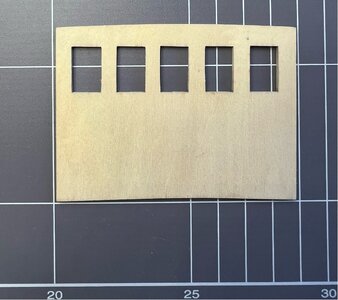
Soaked and bound to the form…
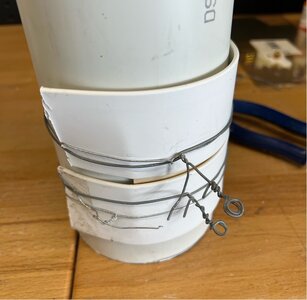
It didn’t look pretty while drying, but the next day it came out very close to what I was after. However it was still keen to relax back toward being flat so it needed to have some internal formwork to hold it to the desired curve while it dried completely. The kit comes with a single thin panel to glue in at floor level, but nothing else. They probably assume that you will glue the roof on to provide the upper support, but that doesn’t suit me, so I made up a form from residual 4mm ply from the laser cut sheets. Both of those were used to temporarily hold the curve while the final drying occurred (another day), then later glued-in in their correct locations.
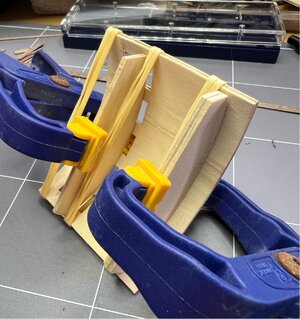
Close to the final product…
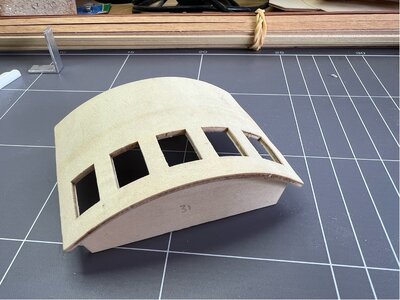
This panel was then planked and window framed to match the rest of the cabin…
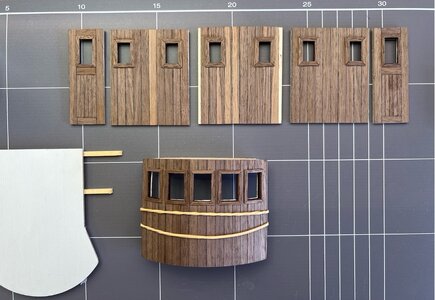
The curved front wall
The front face of the wheelhouse is curved, and the panel is the same 2mm thick 3-ply used for the other walls, so I need to come up with a way to form that curve over a fairly large area of ply that doesn't really like to bend. In the end I found some strong PVC stormwater pipe that had a suitable diameter to form it around. The ply was then soaked for about 20 mins in hot water until I felt it had enough ‘give’ to bend without any splitting or delamination of the ply. While it was soaking, I prepared some covering to go over the ply panel - these are the slats from a PVC venetian blind (recovered when a neighbour was having a clean out) and some tie wire to put some pressure against the panel and pipe.
The laser cut panel was cleaned up prior to bending…

Soaked and bound to the form…

It didn’t look pretty while drying, but the next day it came out very close to what I was after. However it was still keen to relax back toward being flat so it needed to have some internal formwork to hold it to the desired curve while it dried completely. The kit comes with a single thin panel to glue in at floor level, but nothing else. They probably assume that you will glue the roof on to provide the upper support, but that doesn’t suit me, so I made up a form from residual 4mm ply from the laser cut sheets. Both of those were used to temporarily hold the curve while the final drying occurred (another day), then later glued-in in their correct locations.

Close to the final product…

This panel was then planked and window framed to match the rest of the cabin…

GREAT WORK. YOU COULD HAVE USE HOT METHODE HEER TOO -DEPENDING OD THE SEIZE OF THE CAN. VERY WELL DONE. I CAN ONLY HOPE THAT YOU HAVE LOT OF FOLLORS. EL CAPIThanks El Capi, for the suggestion about the heated can...it's a good idea for the strips that you showed being bent (you did a nice job on those). I had already done this part of the build a few weeks ago, and I used a slightly different technique, shown below.
The curved front wall
The front face of the wheelhouse is curved, and the panel is the same 2mm thick 3-ply used for the other walls, so I need to come up with a way to form that curve over a fairly large area of ply that doesn't really like to bend. In the end I found some strong PVC stormwater pipe that had a suitable diameter to form it around. The ply was then soaked for about 20 mins in hot water until I felt it had enough ‘give’ to bend without any splitting or delamination of the ply. While it was soaking, I prepared some covering to go over the ply panel - these are the slats from a PVC venetian blind (recovered when a neighbour was having a clean out) and some tie wire to put some pressure against the panel and pipe.
The laser cut panel was cleaned up prior to bending…
View attachment 442419
Soaked and bound to the form…
View attachment 442420
It didn’t look pretty while drying, but the next day it came out very close to what I was after. However it was still keen to relax back toward being flat so it needed to have some internal formwork to hold it to the desired curve while it dried completely. The kit comes with a single thin panel to glue in at floor level, but nothing else. They probably assume that you will glue the roof on to provide the upper support, but that doesn’t suit me, so I made up a form from residual 4mm ply from the laser cut sheets. Both of those were used to temporarily hold the curve while the final drying occurred (another day), then later glued-in in their correct locations.
View attachment 442421
Close to the final product…
View attachment 442422
This panel was then planked and window framed to match the rest of the cabin…
View attachment 442423
Wheelhouse Interior Fittings
The inside of the wheelhouse has a couple of fittings in the kit. The wheel is diecast and brass plated (see below), and was pretty clean straight from the bag. This was painted to look like a timber wheel with brass reinforcing plates.
The throttle (also below) is made up from a couple of small, machined brass fittings which only needed a short piece of 1mm brass wire added and a timber support post.
To give the fascia of the dashboard a little more strength I added a semi-circle support under the lower edge, matching the upper surface, and also added a small offcut of 4mm ply behind the area where the shaft of the wheel will be mounted.
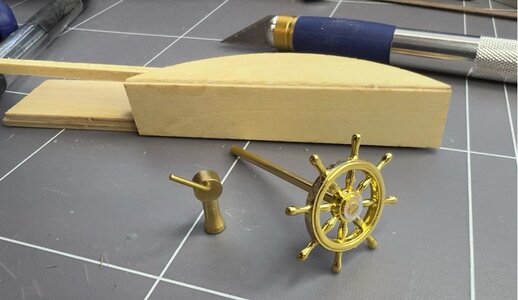
There is a binnacle made from brown plastic (an attempt to look like brass?), with correction balls and a compass face moulded on. There is no direction on how or where to mount this and I tossed up putting it on the flat top of the dashboard or give it a more traditional look with a timber post mount. I decided on the latter and added a brass tube collar to join it together and look a little more like real brass.
Now, I know that the skipper is not very productive until he’s had his cup of coffee, so I had a go at making some scale mugs. A very short length of 2.5 mm brass tube and half a link of anchor chain and it’s almost done.
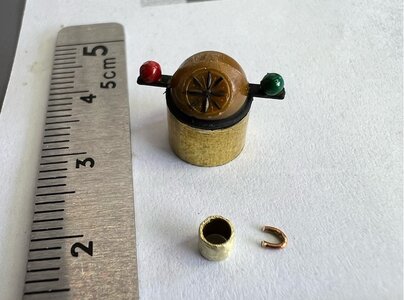
Here’s the view looking forward…
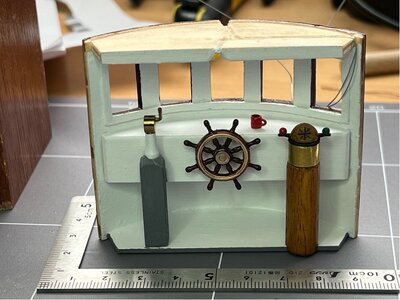
You may also see that I’ve started the wiring for some cabin lighting. A bare LED is mounted overhead, angled into the cabin. The wiring will be hidden in channels I’ve cut into the top of the upper panel and then it will run discreetly down the starboard wall into the floor. There is also an external flood light that will go up top of this wall facing forward and its wiring will run through a similar channel.
The inside of the wheelhouse has a couple of fittings in the kit. The wheel is diecast and brass plated (see below), and was pretty clean straight from the bag. This was painted to look like a timber wheel with brass reinforcing plates.
The throttle (also below) is made up from a couple of small, machined brass fittings which only needed a short piece of 1mm brass wire added and a timber support post.
To give the fascia of the dashboard a little more strength I added a semi-circle support under the lower edge, matching the upper surface, and also added a small offcut of 4mm ply behind the area where the shaft of the wheel will be mounted.

There is a binnacle made from brown plastic (an attempt to look like brass?), with correction balls and a compass face moulded on. There is no direction on how or where to mount this and I tossed up putting it on the flat top of the dashboard or give it a more traditional look with a timber post mount. I decided on the latter and added a brass tube collar to join it together and look a little more like real brass.
Now, I know that the skipper is not very productive until he’s had his cup of coffee, so I had a go at making some scale mugs. A very short length of 2.5 mm brass tube and half a link of anchor chain and it’s almost done.

Here’s the view looking forward…

You may also see that I’ve started the wiring for some cabin lighting. A bare LED is mounted overhead, angled into the cabin. The wiring will be hidden in channels I’ve cut into the top of the upper panel and then it will run discreetly down the starboard wall into the floor. There is also an external flood light that will go up top of this wall facing forward and its wiring will run through a similar channel.
The Wheelhouse Cabin
The main space inside the wheelhouse is empty as far as the kit is concerned, so I’ve added a table and will put a scale map on that before the roof goes on. The grey tube running up the back wall is a conduit for the wiring of all the rear mounted lights (2 x nav side lights, rear facing white light, and rear internal cabin light), the wiring is so fine that 8 individual wires fit through the 2mm tube.
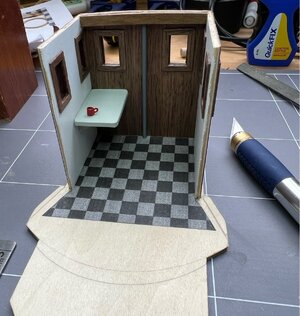
I’ve added an extra brace at the top of the rear wall, using a piece of close-grained 5mm square timber. This change to the kit is there for two reasons…I wanted something that I was confident would take the thread of a few small screws when I attach the roof (it’s slightly curved, so there is some force involved), and also as something to mount the rear cabin LED (it’s not installed in the photo).
Then to the floor. I could have just painted it grey, but I thought it might be more interesting with the chequerboard. I’ve used two shades of grey as I think black and white would make it look like a dolls house kitchen. It is just a laser printed Excel spreadsheet in plain paper that has been sprayed with clear satin acrylic. It is cut off short of the front as that gets covered by the console false floor. I don’t have any crew yet, so they will be added later. Getting very close to gluing in the doors and adding the front wall.
The main space inside the wheelhouse is empty as far as the kit is concerned, so I’ve added a table and will put a scale map on that before the roof goes on. The grey tube running up the back wall is a conduit for the wiring of all the rear mounted lights (2 x nav side lights, rear facing white light, and rear internal cabin light), the wiring is so fine that 8 individual wires fit through the 2mm tube.

I’ve added an extra brace at the top of the rear wall, using a piece of close-grained 5mm square timber. This change to the kit is there for two reasons…I wanted something that I was confident would take the thread of a few small screws when I attach the roof (it’s slightly curved, so there is some force involved), and also as something to mount the rear cabin LED (it’s not installed in the photo).
Then to the floor. I could have just painted it grey, but I thought it might be more interesting with the chequerboard. I’ve used two shades of grey as I think black and white would make it look like a dolls house kitchen. It is just a laser printed Excel spreadsheet in plain paper that has been sprayed with clear satin acrylic. It is cut off short of the front as that gets covered by the console false floor. I don’t have any crew yet, so they will be added later. Getting very close to gluing in the doors and adding the front wall.
As usual a Weel Done work -it is all going into my 1class build. have only one comment. The Trottle should be mainly on the Starboard Side, so you should change the two columns. and then generally the compass Rose in most cases was just in front of the steering wheel. god, luck and go forward as now-
a great admirer of your build. I can only hope a lot of builders will or are following you -mainly geginners, as here there is a lot to learn
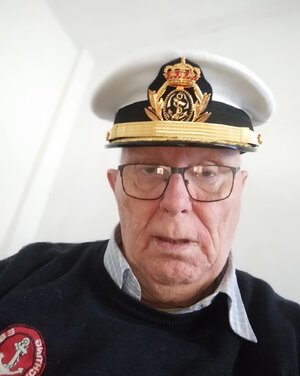
a great admirer of your build. I can only hope a lot of builders will or are following you -mainly geginners, as here there is a lot to learn

for the coffee cups, you should make a square hole with diameter hole drilled in the centre, to avoid cups falling od the floor- in danish slinger grej
Hey Capi, thanks for the nice words of encouragement. I hope I'm striking a reasonable balance between giving a bit of detail to help other beginners who might decide to build this model, but not too much to bore everyone else!
And, thanks for the feedback on the position of the throttle and compass in the real boats. As it happens, I'm writing the log retrospectively, so this part of the build was done back in late Jan/Feb (just looked at the dates on the photos, wow, I can't believe it was that long ago), so I probably won't be able to change the throttle...but, as you will see in the photos of the next post, I did end up changing the compass binnacle, it now sits in front of the skipper as you suggest.
And the coffee cups...a good idea if I was building at full scale, but these ones are filled with Titebond III...it dries the colour of coffee and glues the cups to the table top, all in one go.
And, thanks for the feedback on the position of the throttle and compass in the real boats. As it happens, I'm writing the log retrospectively, so this part of the build was done back in late Jan/Feb (just looked at the dates on the photos, wow, I can't believe it was that long ago), so I probably won't be able to change the throttle...but, as you will see in the photos of the next post, I did end up changing the compass binnacle, it now sits in front of the skipper as you suggest.
And the coffee cups...a good idea if I was building at full scale, but these ones are filled with Titebond III...it dries the colour of coffee and glues the cups to the table top, all in one go.
As you are the Captain, you do it your way, Why I am so much interested in this Mpdel us that i have built myself, and just want my time in the navy. to give your mw advice as have more than 2 years between the Fishing Cutters.Hey Capi, thanks for the nice words of encouragement. I hope I'm striking a reasonable balance between giving a bit of detail to help other beginners who might decide to build this model, but not too much to bore everyone else!
And, thanks for the feedback on the position of the throttle and compass in the real boats. As it happens, I'm writing the log retrospectively, so this part of the build was done back in late Jan/Feb (just looked at the dates on the photos, wow, I can't believe it was that long ago), so I probably won't be able to change the throttle...but, as you will see in the photos of the next post, I did end up changing the compass binnacle, it now sits in front of the skipper as you suggest.
And the coffee cups...a good idea if I was building at full scale, but these ones are filled with Titebond III...it dries the colour of coffee and glues the cups to the table top, all in one go.
In this type of cutter, there were the binnacle, compass etc Not these two columns. These were for bigger ships with one man at the wheel and to the right side the throttle and the Nacigater had the (binnacle) and gave orders to the helmsman,
I was on one of these ships in the Navy Reserve - until I left for Spain-
I will add some images of the model you are building,- only as srt before is it your build
el capo
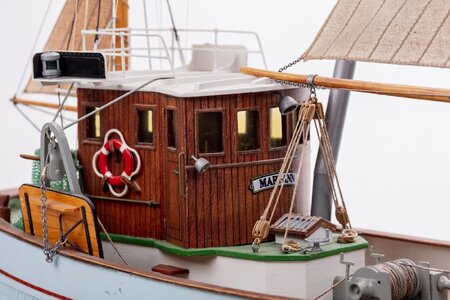
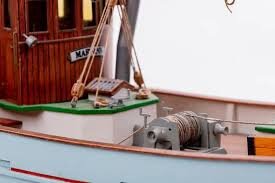
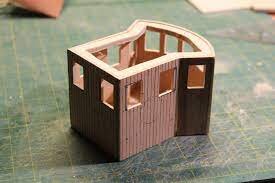
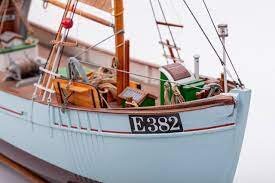
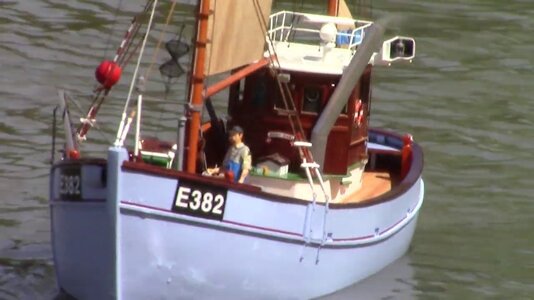
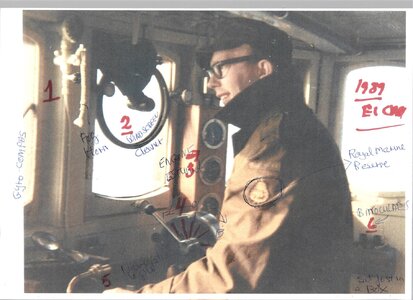
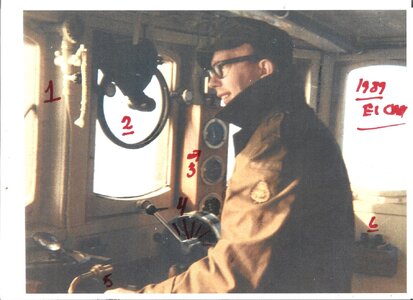
Hey El Capi, thanks for the photos, it's great to hear from someone who has personal experience with both the original vessels and is also a builder of the model itself. That photo of you with the added handwritten notes explaining where everything is in the cabin is a beauty.
Getting close to closing up…
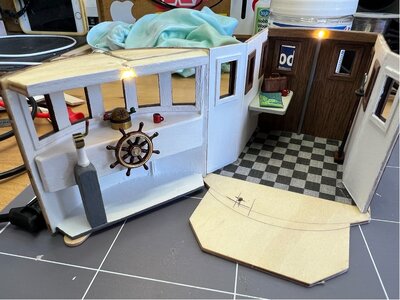
The observant will note that the compass/binnacle has been moved (up onto the dashboard) and its post removed altogether, this is because when I added the front wall, I realised that the post was sitting right in the middle of the starboard doorway and just didn’t look right. Having the compass in front of the skipper makes sense to me...and as recently pointed out by El Capi, this is where it would be on the real vessel. Unfortunately, the build has progressed too far to also move the throttle to the other side of the wheel, so I'll live with that difference.
The small hole in the bare section of the floor is to take the light wiring from the front wall into the underfloor area. You can see the interior lights working in the photo. I’ve also added a few other bits like the captain’s bag on the table (it’s actually an unusually shaped oil drum from a plastic kit), an extra coffee mug (filled with coffee), a map, and a couple of poles with hooks on the wall.
Here is it being glued together. It looks a little rough in that photo, but that’s because I did the gluing in two stages (each side, starting on the far side) so that I could true up each side separately - it had a slight twist in the front curved structure. The walls/door were also built a little long with the intention of sanding them to a consistent height once assembled.
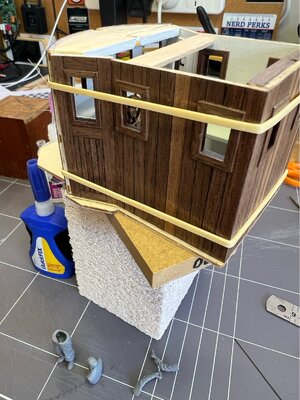

The observant will note that the compass/binnacle has been moved (up onto the dashboard) and its post removed altogether, this is because when I added the front wall, I realised that the post was sitting right in the middle of the starboard doorway and just didn’t look right. Having the compass in front of the skipper makes sense to me...and as recently pointed out by El Capi, this is where it would be on the real vessel. Unfortunately, the build has progressed too far to also move the throttle to the other side of the wheel, so I'll live with that difference.
The small hole in the bare section of the floor is to take the light wiring from the front wall into the underfloor area. You can see the interior lights working in the photo. I’ve also added a few other bits like the captain’s bag on the table (it’s actually an unusually shaped oil drum from a plastic kit), an extra coffee mug (filled with coffee), a map, and a couple of poles with hooks on the wall.
Here is it being glued together. It looks a little rough in that photo, but that’s because I did the gluing in two stages (each side, starting on the far side) so that I could true up each side separately - it had a slight twist in the front curved structure. The walls/door were also built a little long with the intention of sanding them to a consistent height once assembled.

Crew
In the photo in the last post you can see the skipper being put together at the bottom of frame. I bought a plastic kit from the local hobby shop. I haven’t come across much in the way of ship’s crew in the 1/33 or similar scale. This kit is 1/35 from MiniArt and is called “German Tankers Refueling”. It has two men and a range of fuel drums. I’ll modify their hats to look less military and glue their arms at angles that suit my purposes. They are quite well moulded and after a little cleaning and gluing they look good.
Here's the skipper getting a feel for the controls…
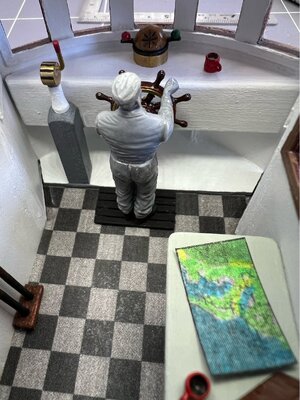
That’s a map of the NSW coast and the entrance to the Hunter River and Lake Macquarie, so he doesn’t get lost (not that he will be doing any commercial fishing in the lake these days).
I’m off to get some more paint so that I can add a little colour to his face and give him some appropriate clothing.
In the photo in the last post you can see the skipper being put together at the bottom of frame. I bought a plastic kit from the local hobby shop. I haven’t come across much in the way of ship’s crew in the 1/33 or similar scale. This kit is 1/35 from MiniArt and is called “German Tankers Refueling”. It has two men and a range of fuel drums. I’ll modify their hats to look less military and glue their arms at angles that suit my purposes. They are quite well moulded and after a little cleaning and gluing they look good.
Here's the skipper getting a feel for the controls…

That’s a map of the NSW coast and the entrance to the Hunter River and Lake Macquarie, so he doesn’t get lost (not that he will be doing any commercial fishing in the lake these days).
I’m off to get some more paint so that I can add a little colour to his face and give him some appropriate clothing.


